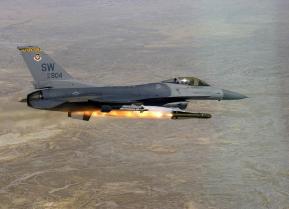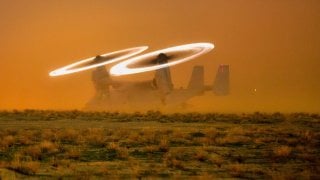20 MV-22 Osprey Did an ‘Elephant Walk’ and It Was Glorious
Seeing 20-odd MV-22s lined up on the runway together was a head-turner. The tiltrotor Osprey is a distinct aircraft. First procured in 1999, the Osprey has been a foundation of the Marine Air-Ground Task Force for over two decades.
The term “elephant walk” refers to a military training exercise in which a number of aircraft taxi en masse and then take off in quick succession. The practice dates back to World War II, and the term came from bomber missions that required dozens of bombers to carry out the maneuver. The lumbering bombers, moving down the runway in unison, resembled a group of elephants walking nose-to-tail.
While the term originates from bomber activity, the modern exercise is most closely associated with fighter aircraft, which are often featured in elephant walks to show rival nations exactly how daunting U.S. airpower is. The sight of dozens and dozens of fighters marching down the runway together has become somewhat commonplace.
The U.S. Marine Corps MV-22 Osprey elephant walk conducted on June 6, 2019, however, was different
“Seven squadrons with Marine Aircraft Group (MAG) 16, 34d Marine Aircraft Wing (MAW) conducted a massive training evolution during which 26 MV-22B Ospreys and 14 Ch-53E Super Stallions…took part in a combat readiness exercise that saw them depart and soared over Southern California,” The Aviationist reported at the time.
“MAG-16 has executed our maximum flight even to demonstrate the combat readiness of our MAG and to tell the MAG-16 story,” Col. Craig C. Leflore said in a public statement. “We want to test ourselves. If there is a crisis somewhere in the world, our job is to be ready to respond to that crisis at a moment’s notice.”
Leflore continued, “MAG-16 provides the Marine Air-Ground Task Force (MAGTF) commander with the assault support transportation of combat troops, supplies and equipment, day or night under all weather conditions during expeditionary, joint or combined operations.
“I can’t think of a better way for the MAG to celebrate the 75th Anniversary of D-Day and the accomplishments of those who have gone before us."

Osprey Elephant Walk
Seeing 20-odd MV-22s lined up on the runway together was a head-turner. The tiltrotor Osprey is a distinct aircraft. First procured in 1999, the Osprey has been a foundation of the Marine Air-Ground Task Force for over two decades. This relies heavily on the Osprey’s ability to combine the characteristics of a helicopter with those of fixed-wing aircraft. Namely, the Osprey is capable of vertical flight (like a helicopter), but can also reach the speed, range, and endurance of fixed-wing transports. The combination is ideal for transporting Marines into hard-to-reach places.
“The Osprey is capable of carrying more than 2 Marines more than 400 nautical miles at a cruise speed of 266 knots,” the USMC press release said. “The superb capabilities of the MV-22 translate into a faster MAGTF response in times of crisis. Those capabilities are put into practice around the world every day by MAG-16.”
Any elephant walk is meant to serve as a signal to rival nations — it is a show of force. An elephant walk featuring the tiltrotor Osprey is an especially pointed signal, given that U.S. rival nations do not possess tiltrotor flight technology. Seeing over two dozen Ospreys on the tarmac is a reminder that the U.S. boasts the most advanced military technology on Earth.
About the Author: Harrison Kass
Harrison Kass is the Senior Editor with over 1,000 published defense pieces. An attorney, pilot, guitarist, and minor pro hockey player, Harrison joined the US Air Force as a Pilot Trainee but was medically discharged. Harrison holds a BA from Lake Forest College, a JD from the University of Oregon, and an MA from New York University. Harrison listens to Dokken.
All images are Creative Commons.


